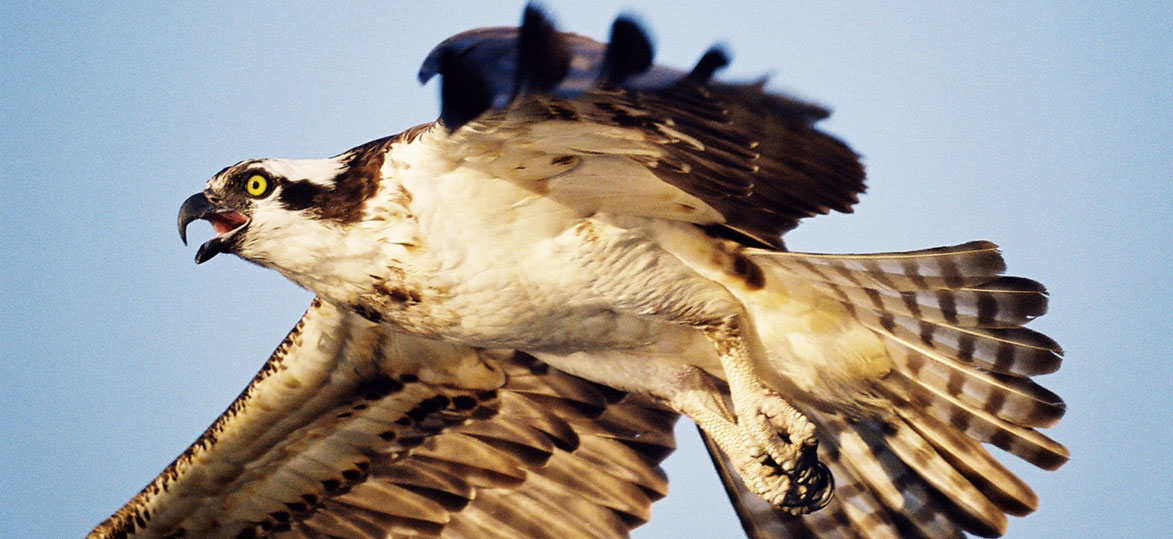
Also known as the "fish-hawk," the Osprey (Pandion haliaetus) is a bird of prey that nests near large areas of water.
The crooked bend of the wings in flight is characteristic of the osprey. A dark line through the eye area is another important identifying feature.
The Osprey has a dark brown back. The underside is white with a lightly brown-spotted breast. Spotting may be absent in males. Bright yellow eyes stare from a small, narrow head. Sharp talons, used for hunting, protrude from the end of powerful legs. Juveniles have a speckled back and wings and red eyes.
Their calls include clear whistles to shrill cries indicate increasing levels of alarm.
Habitat
Ospreys breed near large bodies of water with an abundant supply of fish. In Vermont they nest near lakes and rivers, occasionally in loose colonies. The nest is a large, bulky pile of sticks, put together on the top of a tall dead tree, a rocky ledge, telephone pole cross arms, or an artificial platform.
In the eastern U.S., breeding occurs from Maine to Florida. Many ospreys from Vermont are likely to spend their winters as far south as Central America. In Vermont, Ospreys can be found along Lake Champlain, Lake Memphremagog, and the Connecticut River and may occasionally be seen fishing on other water bodies.
Reproduction
Ospreys lay two to four white or milky-white eggs, heavily marked with brown.
Diet
The primary food is fish when they swim close to the surface such as perch, suckers, and bullhead. Ospreys capture by their prey by plummeting from the air and grabbing with their talons.
Management
Higher productivity of Ospreys in Vermont in recent years has occurred due to the efforts of many people and organizations including the Vermont Fish & Wildlife Department, the U.S. Fish and Wildlife Service, and Vermont power companies.
Management activities include:
- Artificial nesting platforms have been put up in appropriate areas through cooperation with power companies and other landowners. Many have been used by ospreys to build nests and raise young.
- Bands of metal (predator guards) are placed around trees and platform poles where ospreys are nesting to minimize the approach of predators from the ground.
- Nesting areas are monitored so the number of young raised can be tracked and so that disturbances by people can be minimized through placement of warning signs if needed.
- Observations are noted as to where ospreys frequently occur so that nesting platforms can be put up in those areas.
What you can do
- Avoid getting too close to nesting sites during the breeding season. Honor warning signs when posted.
- Maintain a respectful distance from wild animals. Travel with binoculars! If an animal vocalizes when you're near its territory, immediately back off.
- Observe and report on osprey nesting activities in your area.
- Report sightings of Osprey, especially at natural tree nests, to the Essex District Office at 802-878-1564.
- Donate any amount to the Nongame Wildlife Fund on your Vermont income tax form, while purchasing a hunting and fishing license, or by direct donation.
Status
The Osprey is one of the first species removed from the state's endangered species list. Their recoveries came about because state and federal wildlife agencies, non-governmental organizations, electric utilities, and private landowners collaborated to address the problems that had decimated the birds' populations: habitat loss, pollutants such as lead and mercury, and pesticides that weaken eggs.
